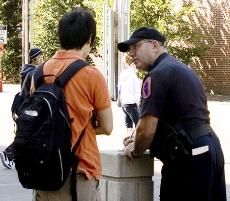Police enforce pedestrian safety

Sky Opila The Daily Illini
Oct 4, 2006
Last updated on May 12, 2016 at 05:04 a.m.
Inside his squad car, Sgt. Tom Geis is constantly on the lookout for students haphazardly crossing campus streets.
“When you’re driving around between high class time and there is a lot of backup, that is when frustration level is high, and we have a lot of problems,” said Geis, day shift commander for the University of Illinois Police Department.
As Geis drives around in his squad car everyday, he notices the problem intersections. These include the corners of Sixth and John streets, Wright and Green streets, Sixth and Armory streets, and Armory and Wright streets, along with several others. These intersections become flooded with pedestrians who are in a hurry before and after class and who often neglect safety around the roadway.
“All intersections at the core of campus are problematic,” said Lt. Skip Frost, patrol division commander. “We have a higher population density in the center of campus than a lot of areas in Chicago or New York City because we have so many people sharing such a limited amount of space.”
Get The Daily Illini in your inbox!
To keep everyone safe, the University Police Department offers safety presentations in the residence halls and mandatory presentations for incoming freshmen. They monitor dangerous intersections and issue warnings and citations to students who are not in compliance with the rules.
Curt Bolding, University police officer, stands on the corners of problem intersections about four to five days a week. He observes as pedestrians cross the streets and makes sure that everyone is complying with the safety rules.
“We give out warning tickets as an educational tool,” Bolding said. “I’ve written over 100 warnings since the beginning of the school year.”
The warning tickets do not cost any money; they are simply tools the University Police Department uses to make pedestrians aware when they have done something wrong. The department does give out a $75 fine for people blatantly breaking rules; Officer Bolding, though, said he has never written one.
Even though Mitch Kobylarczyk, senior in Engineering, was issued a pedestrian warning ticket from Officer Bolding, he will not comply in the future.
“I’m still going to cross whenever I see it’s clear,” Kobylarczyk said.
Many officers have realized that the biggest problem they face is confusion about the laws.
“The traffic light is for cars, the walk/don’t walk signal is for pedestrians. Sometimes the light turns green, but it is still not safe for pedestrians to walk,” Bolding said.
Moreover, the department has been working toward the ultimate goal of voluntary compliance. Voluntary compliance means that pedestrians and drivers will obey the rules without requiring that police look over their shoulder.
“No matter how hard we work, there are 55 of us and 40,000 students,” Frost said. “We cannot be there every minute of every day, so you have to look out for your own safety.”
“In general, we have a long way to go with compliance,” said University Chief of Police Kris Fitzpatrick. “While we’ve educated people we just haven’t found the right incentive yet.”
The law states that vehicles have the right of way until pedestrians have established themselves in the crosswalk, Geis said. If a pedestrian is standing on the side of the road, near a crosswalk, but not in it, then a vehicle does not have to yield.
“The rule of thumb is wait for a natural break in the traffic and then enter the crosswalk,” Geis said. “Once you enter the crosswalk, then you have the right of way.”
However, students tend to feel that if the yellow yield signs are up, an invisible force field exists that will protect them, allowing them to not pay attention when entering the roadway, Frost said.
“People will walk out with cell phone in one ear, iPod in the other and just walk right across without even looking,” Geis said. “As a pedestrian or a bicyclist, you should make it clear, at least yield or stop before entering an intersection.”
Frost said he feels that students doing their part would make his job a success.
“If I could get every pedestrian just to look both ways before they cross the street, that’d be great,” Frost said.





